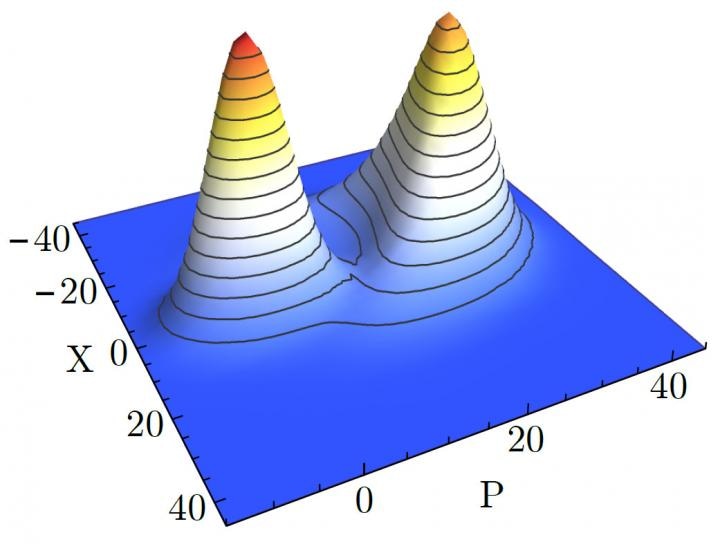Feb 3 2017
 This is the probability distribution showing the equal likelihood for the cavity being transparent and opaque at the critical point. Credit J. FINK
This is the probability distribution showing the equal likelihood for the cavity being transparent and opaque at the critical point. Credit J. FINK
The very first experimental observation of a first-order phase transition in a dissipative quantum system was reported by a team of scientists headed by Johannes Fink from the Institute of Science and Technology Austria (IST Austria).
Phase transitions are frequently encountered in everyday life while observing the change of the state of matter, for instance the freezing of water at the critical temperature of 0 °C. However, phase transitions also take place at the quantum mechanical level, where they are relatively unexplored even though they are considered to be significant for different fields of physics.
The photon-blockade breakdown, discovered only two years ago, is one example of a phase transition at the quantum level. A photon fills a cavity in an optical system during photon blockade in order to prevent other photons from entering the same cavity until it leaves, blocking the flow of photons.
Increase in the photon flux to a particular level could lead the occurrence of a quantum phase transition: The photon blockade breaks down, and the state of the system transforms from opaque to transparent. Currently, this particular phase transition is being experimentally observed by researchers who, for the the very first time, successfully met the extremely specific conditions that are essential to completely study this effect.
The continuous tuning of an external parameter, for instance temperature, leads to a transition between two powerful steady states with varied attributes during a phase transition. First-order phase transitions are determined by a coexistence of the two stable phases when the control parameter is within a specific range close to the critical value.
The two phases develop a mixed-phase where a few parts have completed the transition while others have not, like in a glass in which both water and ice are present at the same time. The recently published results by Fink and his collaborators in the journal Physical Review X provide an insight into the quantum mechanical basis of this effect in a microscopic, zero-dimensional system.
Their setup comprised of a microchip with a superconducting microwave resonator performing as the cavity and a few superconducting qubits behaving as the atoms. The chip was cooled to a temperature amazingly close to absolute zero – 0.01 Kelvin – so that thermal fluctuations did not take part in the process.
The researchers produced a flux of photons by sending a constant microwave tone to the input of the resonator on the chip. They amplified and measured the transmitted microwave flux on the output side. The researchers further detected a signal flipping stochastically between zero transmission and full transmission for specific input powers: the anticipated coexistence of both phases had occurred.
We have observed this random switching between opaque and transparent for the first time and in agreement with theoretical predictions.
Johannes Fink, IST Austria
Potential future applications include memory storage elements and also processors for quantum simulation. “Our experiment took exactly 1.6 milliseconds to complete for any given input power. The corresponding numerical simulation took a couple of days on a national supercomputer cluster. This gives an idea why these systems could be useful for quantum simulations,” Fink explains.
In 2016, Johannes Fink came to IST Austria to start his working group on Quantum Integrated Devices. The key objective of his group is to improve and combine quantum technology for chip-based computation, sensing, and communication.